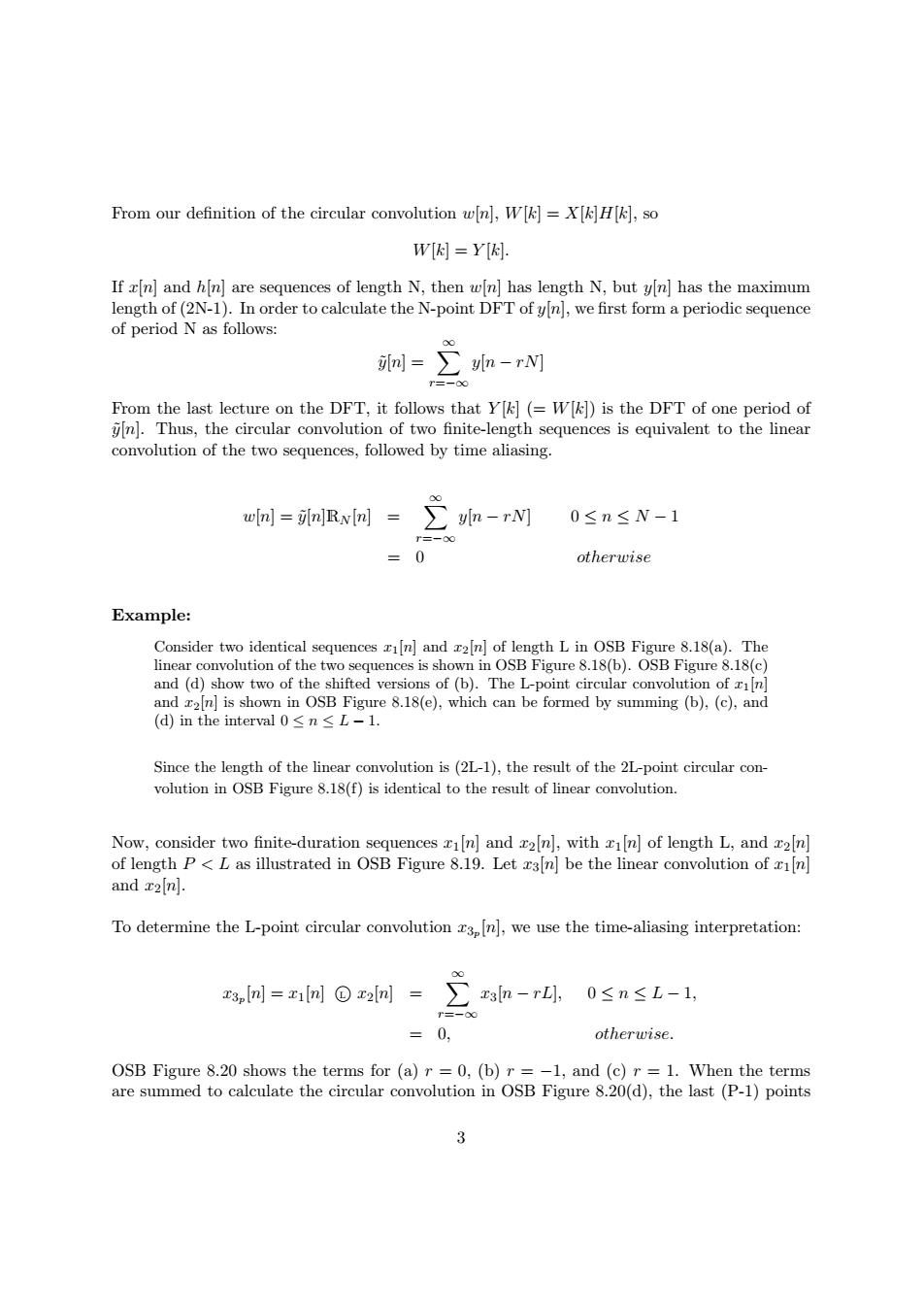正在加载图片...

From our definition of the circular convolution w[n],Wk]=Xk H[k],so W [k]=Y [k]. If xIn]and hin]are sequences of length N,then wIn]has length N,but yn]has the maximum length of(2N-1).In order to calculate the N-point DFT ofyn],we first form a periodic sequence of period N as follows: 00 m=∑n-rN] T=-00 From the last lecture on the DFT,it follows that Yk](=W[k])is the DFT of one period of n].Thus,the circular convolution of two finite-length sequences is equivalent to the linear convolution of the two sequences,followed by time aliasing. wl=i(n]Rw(n]=∑ln-rW 0≤n≤N-1 =0 otherwise Example: Consider two identical sequences 1n]and x2n]of length L in OSB Figure 8.18(a).The linear convolution of the two sequences is shown in OSB Figure 8.18(b).OSB Figure 8.18(c) and(d)show two of the shifted versions of(b).The L-point circular convolution of iln] and z2[n]is shown in OSB Figure 8.18(e),which can be formed by summing (b),(c),and (d)in the interval0≤n≤L-1. Since the length of the linear convolution is(2L-1),the result of the 2L-point circular con- volution in OSB Figure 8.18(f)is identical to the result of linear convolution. Now,consider two finite-duration sequences i[n]and z2[n],with zi[n]of length L,and x2[n] of length P<L as illustrated in OSB Figure 8.19.Let z3[n]be the linear convolution of [n] and z2nj. To determine the L-point circular convolution z3[n],we use the time-aliasing interpretation: 3pm=xm⊙x2nl=∑x3m-r,0≤n≤L-1, r=-00 =0, otherwise. OSB Figure 8.20 shows the terms for (a)r =0,(b)r=-1,and (c)r =1.When the terms are summed to calculate the circular convolution in OSB Figure 8.20(d),the last (P-1)points 3� From our definition of the circular convolution w[n], W[k] = X[k]H[k], so W[k] = Y [k]. If x[n] and h[n] are sequences of length N, then w[n] has length N, but y[n] has the maximum length of (2N-1). In order to calculate the N-point DFT of y[n], we first form a periodic sequence of period N as follows: ∞ y˜[n] = � y[n − rN] r=−∞ From the last lecture on the DFT, it follows that Y [k] (= W[k]) is the DFT of one period of y˜[n]. Thus, the circular convolution of two finite-length sequences is equivalent to the linear convolution of the two sequences, followed by time aliasing. ∞ w[n] = y˜[n]RN [n] = � y[n − rN] 0 ≤ n ≤ N − 1 r=−∞ = 0 otherwise Example: Consider two identical sequences x1[n] and x2[n] of length L in OSB Figure 8.18(a). The linear convolution of the two sequences is shown in OSB Figure 8.18(b). OSB Figure 8.18(c) and (d) show two of the shifted versions of (b). The L-point circular convolution of x1[n] and x2[n] is shown in OSB Figure 8.18(e), which can be formed by summing (b), (c), and (d) in the interval 0 ≤ n ≤ L − 1. Since the length of the linear convolution is (2L-1), the result of the 2L-point circular convolution in OSB Figure 8.18(f) is identical to the result of linear convolution. Now, consider two finite-duration sequences x1[n] and x2[n], with x1[n] of length L, and x2[n] of length P < L as illustrated in OSB Figure 8.19. Let x3[n] be the linear convolution of x1[n] and x2[n]. To determine the L-point circular convolution x3p [n], we use the time-aliasing interpretation: ∞ x3p [n] = x1[n] L x2[n] = � x3[n − rL], 0 ≤ n ≤ L − 1, r=−∞ = 0, otherwise. OSB Figure 8.20 shows the terms for (a) r = 0, (b) r = −1, and (c) r = 1. When the terms are summed to calculate the circular convolution in OSB Figure 8.20(d), the last (P-1) points 3